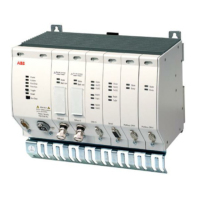4 Cabling the AC 800F
4-44
The splice box is a special housing for protecting the splice point and winding up the
surplus cable length. If the boxes have to meet special requirements for your
application - e.g. mounting in 19“ cabinets or integration of routers please contact us
for more information.
Although only one wire pair is needed for an Ethernet link, it is recommended to use
multi-wire cables in order to allow for possible future expansions/additional data links
in future. Moreover, you can change over to an unused wire in case of wire-break.
When designing a larger network please contact us for more information. Several
standardized cabling concepts enabling future network expansions already exist.
4.2.10.4 Links between buildings
Always use fiber optic cables for links between buildings. Fiber optic cables provide
for protective voltage separation and ensure lightning protection without requiring
additional measures. Besides the indoor cables already described above, outdoor and
underground cables are also available.
Use multi-wire cable to reduce cable laying cost. As already mentioned for indoor
cable links, multi-wire cables enable additional data links in future. Moreover, you can
change over to an unused wire in case of wire-break.
Several outdoor cable types - e.g. gopher-protected or with a special steel or aramid
reinforcement - are available. Note that steel-reinforced cables should only be used
under special conditions for outdoor applications. In this case, the reinforcement must
be grounded at both ends when entering the buildings to provide lightning protection.
When cabling underground and outdoor cables proceed as described in Section
4.2.10.3. The information about splice boxes given in that section is analogously valid
for these cables. Contact us for more information about how to select the appropriate
splice boxes and cable types. Sealed underground splice boxes are also available.

